PR
X
Keyword Search
▼キーワード検索
Comments
続日本100名城東北の…
New!
オジン0523さん
2025年版・岡山大学… New!
隠居人はせじぃさん
New!
隠居人はせじぃさん
【甥のステント挿入… Gママさん
Gママさん
ムベの実を開くコツ… noahnoahnoahさん
noahnoahnoahさん
エコハウスにようこそ ecologicianさん
2025年版・岡山大学…
 New!
隠居人はせじぃさん
New!
隠居人はせじぃさん【甥のステント挿入…
 Gママさん
Gママさんムベの実を開くコツ…
 noahnoahnoahさん
noahnoahnoahさんエコハウスにようこそ ecologicianさん
Calendar
カテゴリ: 海外旅行
ギャラリー5は「包囲の人々」というテーマで、写真のように アスローンの包囲戦に
巻き込まれた17世紀の代表的な人物を彫刻 で展示している。
攻撃と防御を主導した軍の将軍を含む8人の主要なキャラクターの等身大の彫刻で表現 している
のであった。
COLONEL RICHARD GRACE

近づいて。

「 COLONEL RICHARD GRACE
Colonel Richard Grace (c. 1612–1691) was an Irish Royalist soldier who fought for Charles I, Charles II and James II. He served in the Royalist Army in Exile during the 1650s.
【 リチャード・グレース大佐(約1612年 – 1691年)
リチャード・グレース大佐は、アイルランド出身の王党派(ロイヤリスト)の軍人であり、
1650年代には、亡命中の王党派軍(Royalist Army in Exile)に所属していました。】
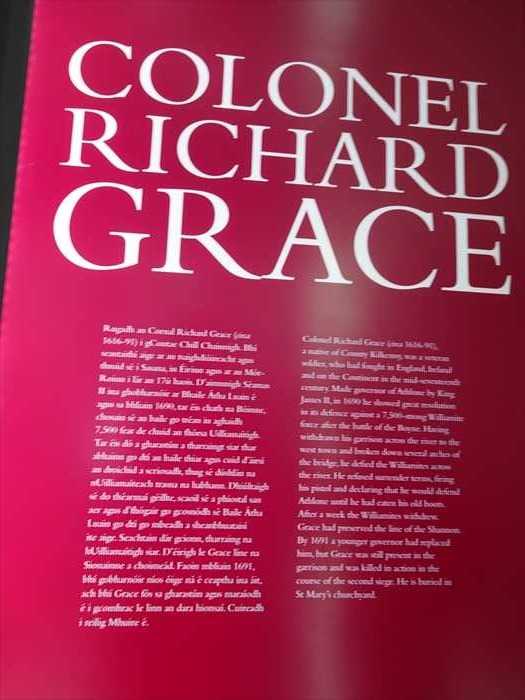
「 COLONEL GUSTAVUS HAMILTON 」
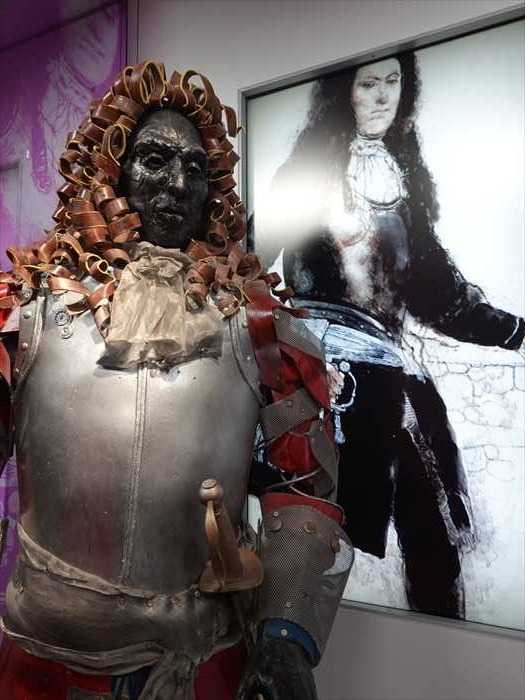
「 COLONEL GUSTAVUS HAMILTON

「 JEAN DE BONNAC MARQUIS D'USSON 」
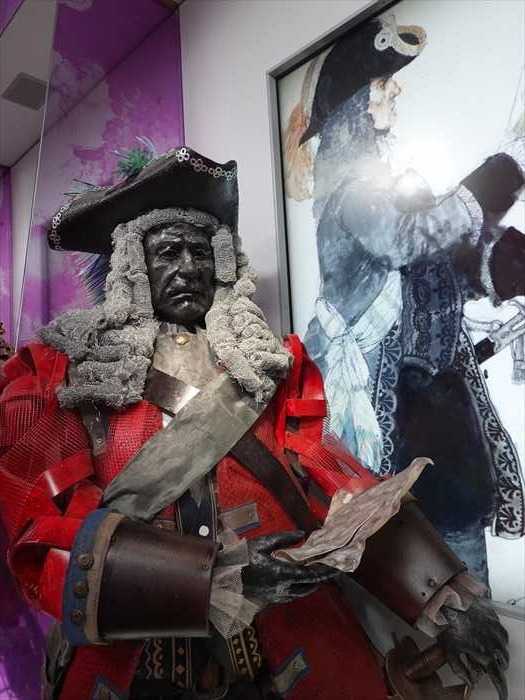
「 JEAN DE BONNAC MARQUIS D'USSON
【ジャン・ルイ・デュッソン、ユッソン侯爵(Marquis de Bonnac)は、1716年から1724年まで
フランスのオスマン帝国駐在大使を務めました。
「ジェントルマンの眠る像(Resting Gentleman)」。
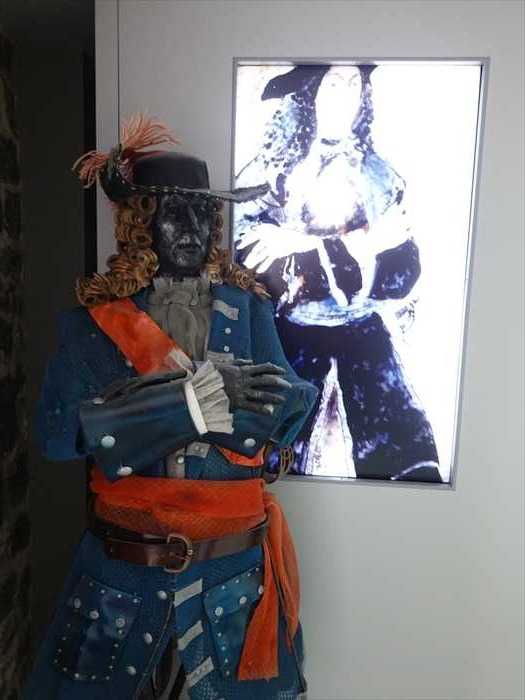
?????
当時の軍事命令書、戦争記録、または犠牲者名簿のモニュメント的なレプリカ?
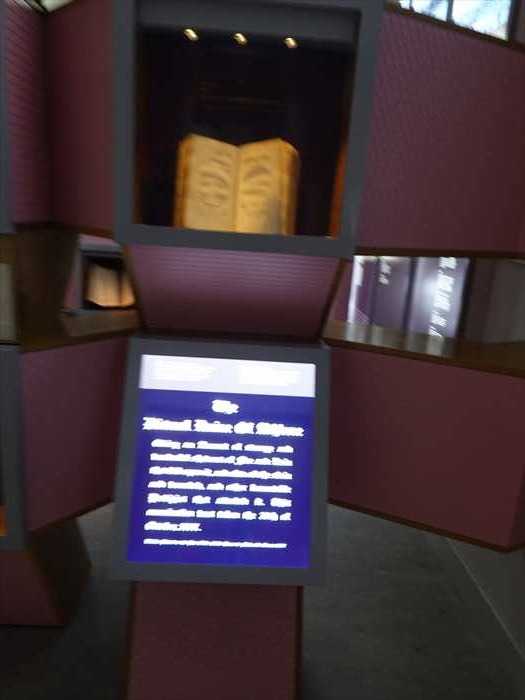
AFTERMATH OF THE SIEGE AND REBUILDING」
【 包囲戦の余波と再建 】
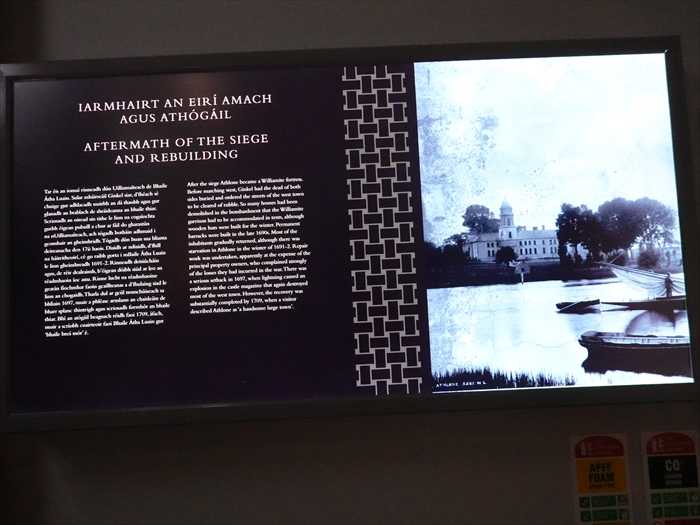

「 FORBAIRT AN CHAISLEÁIN I RÉ NAIPÓLÓN
DEVELOPMENT OF THE CASTLE IN THE NAPOLEONIC ERA 」

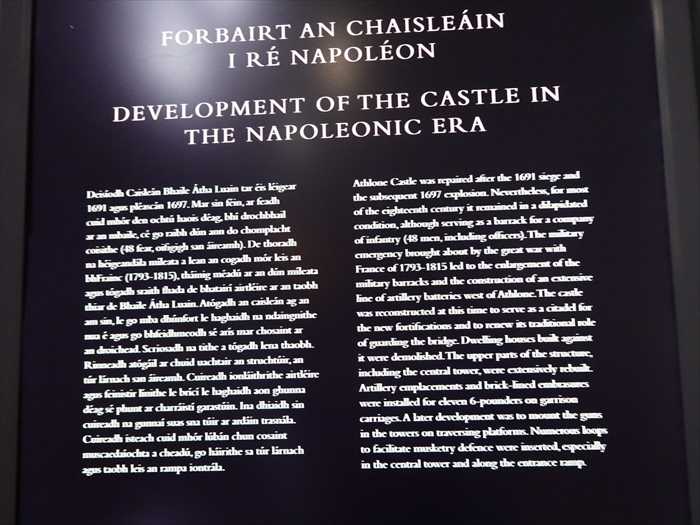
「 (砲台群)
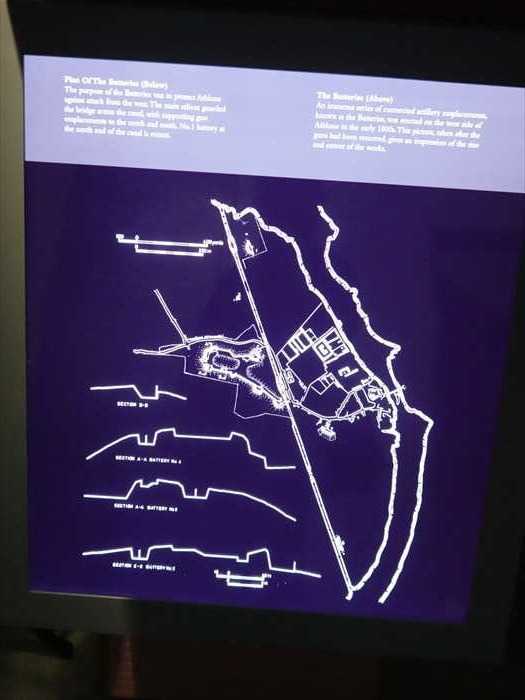
「 Plan of The Batteries (below)
The project shown here was to protect Athlone’s river crossing. It features two major gun batteries, one beside the road and another across the bridge on the south side, with
supporting gun emplacements to the north and south. Note battery at the north
end of the canal is recent.」
【 砲台配置図(下部)
この図面は、アスローンの河川横断地点を防衛するための計画を示しています。2つの主要な
砲台があり、1つは道路のそば、もう1つは橋の南側に位置しています。これを補完する形で、
北と南にも砲座が設置されています。図中、運河の北端にある砲台は比較的新しいものです。】
右:
【 砲台群(上部)
「バッテリーズ(砲台群)」と呼ばれる大規模で連結された砲兵陣地が、1800年代初頭に
アスローンの西側に築かれました。この写真は、大砲が撤去された後に撮影されたもので、
構造物の規模と範囲を示しています。】

「 The Dismal Ruine of Athlone(アスローンの悲惨な廃墟)」と、
「Ranelagh School(ラネラ・スクール) 」に関する解説パネル。
左:
「 The Dismal Ruine of Athlone(Below)
Lightning struck the magazine in Athlone Castle in 1697, causing an explosion and
fire that destroyed 64 houses in the west town, newly rebuilt after the destruction of
the siege. Most of the remaining houses were left uninhabitable, and there were
six fatalities.」
【 アスローンの悲惨な廃墟
1697年、アスローン城の弾薬庫に落雷があり、爆発と火災を引き起こしました。この事故で、
西側の町にあった家屋64軒が焼失しました。これらは、包囲戦後に再建されたばかりの
建物でした。残った家々もほとんどが住めない状態となり、6名の犠牲者が出ました。】
右:
「 Ranelagh School(Above)
Established in 1764 with an endowment from the 1st Earl of Ranelagh, the school was
located in a purpose-built building designed by the distinguished Georgian architect,
George Ensor. Its original function was to provide free education for the children of poor protestants.」
【 ラネラ・スクール
1764年、初代ラネラ伯爵からの寄付によって設立されたこの学校は、著名なジョージアン様式
建築家ジョージ・エンソーによって設計された専用の校舎に設置されました。
元々は、貧しいプロテスタントの子供たちに無償の教育を提供することを目的としていました。】
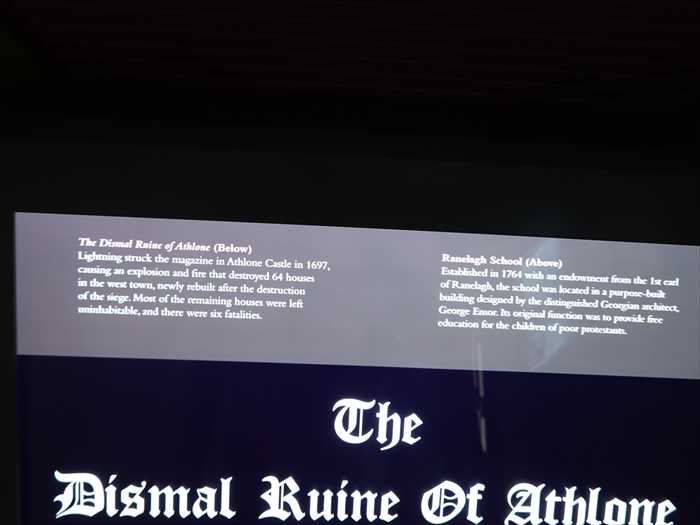
「 BAILE ÁTHA LUAIN MAR BHAILE GARASTÚIN
ATHLONE AS A GARRISON TOWN 」

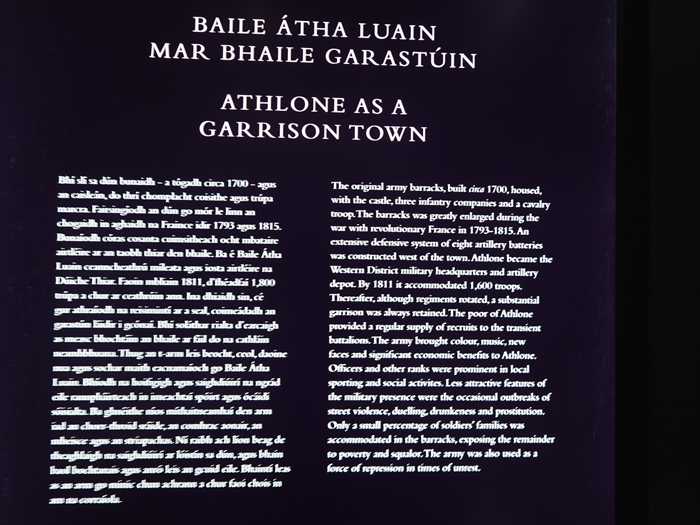
アイルランドとアスローンの社会・政治・軍事史に関する年表パネル ?
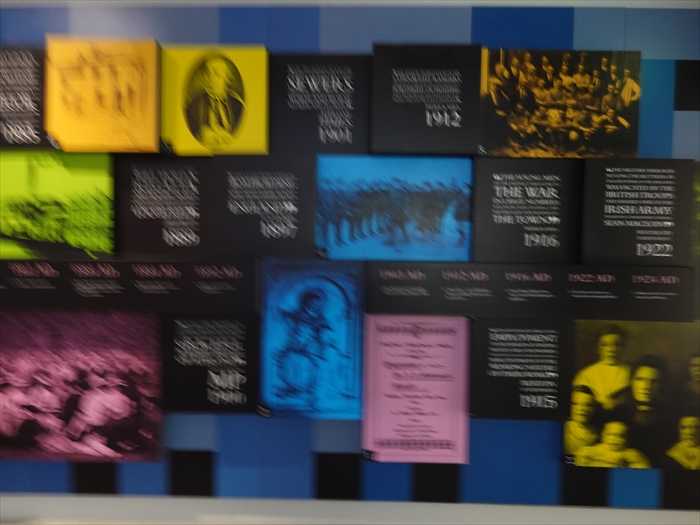
大型の銀製トロフィー。
アスローン周辺で行われたスポーツ競技(特にボートレースやラグビー、あるいは地元の軍事
関連行事)に関する記念杯であっただろうか?
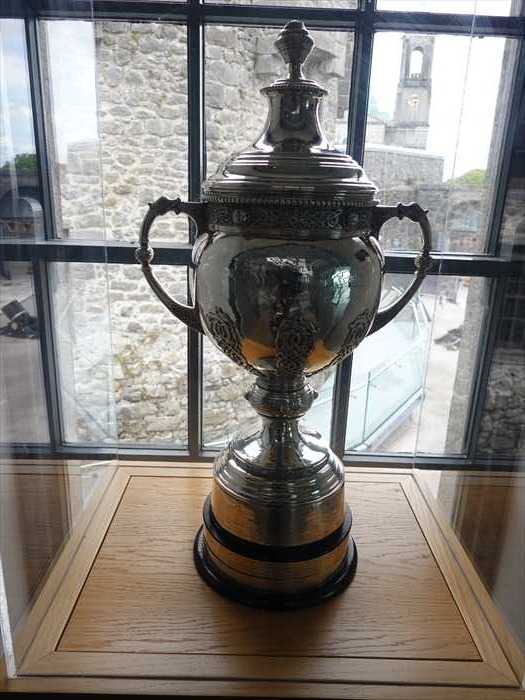
アスローン城(Athlone Castle)の上階・窓越しから、 シャノン川に架かる
アスローン橋(Athlone Bridge)を見下ろす 。
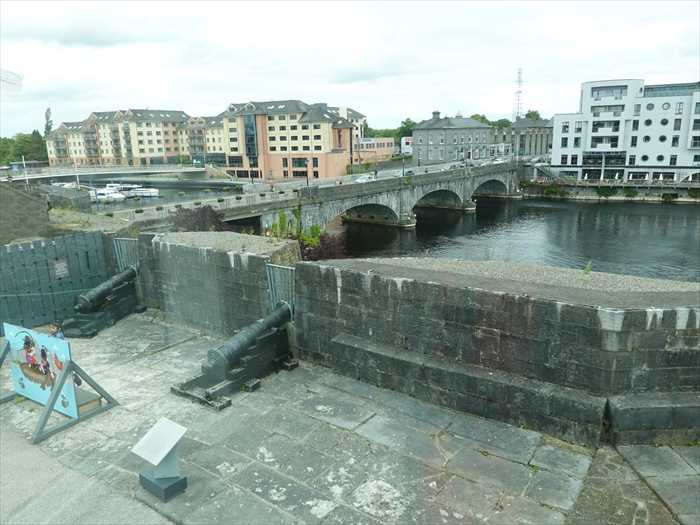
蒸気ホイッスル(steam whistle) と呼ばれる、かつて工場でシフト交代用に
使用されていた音響信号装置。
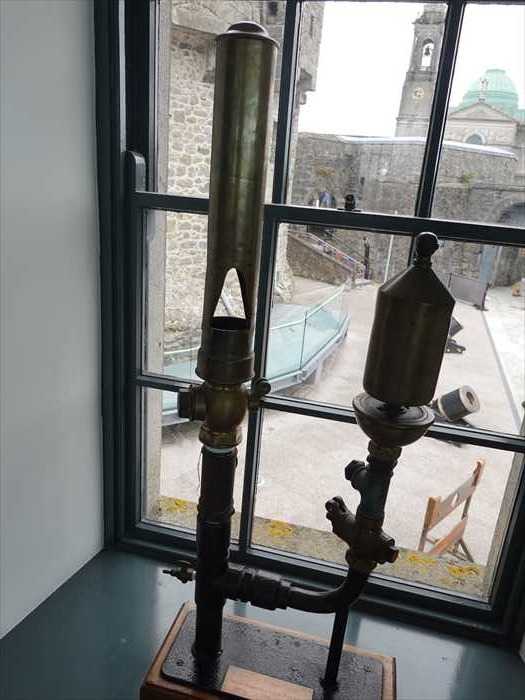
「 Gentex factory hooter
General Textiles Limited (Gentex), a cotton manufacturing plant, made an enormous
contribution to the economy and general life of Athlone during the nearly fifty years of its existence. Shift changes were indicated by the factory hooter, which was audible
throughout the town.」
【 ジェンテックス工場のホイッスル(サイレン)
鳴り響いていたのです。】
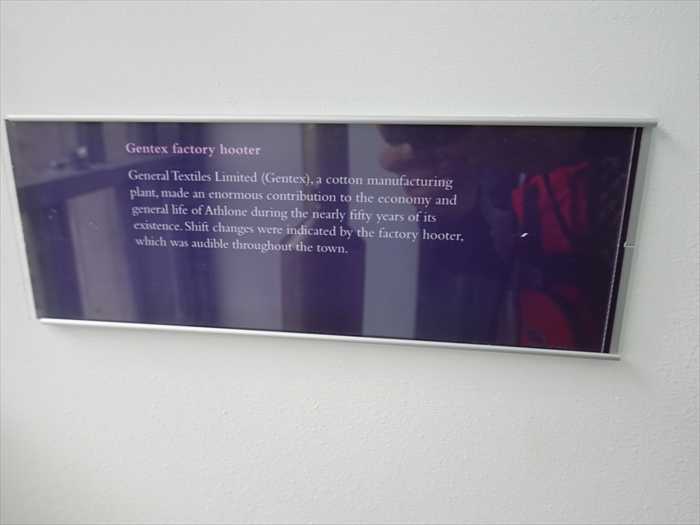
アスローン城(Athlone Castle)の上階、 屋上の砲台跡(バッテリー)に通じる
出入り口付近 。
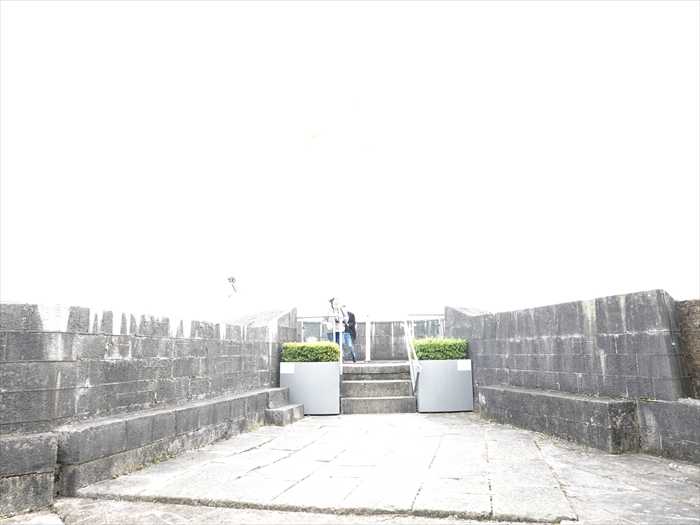
アスローン城(Athlone Castle)の砲台跡に据え付けられている 歴史的な大砲(カノン砲) を
後方から

再び、 アスローン城(Athlone Castle)の主塔(ドンジョン/keep) を正面から。

アスローン城(Athlone Castle)の 屋上バッテリー(砲台)エリアから、聖ペテロ・聖パウロ教会(Church of Saints Peter and Paul)を背景に 。

訪問者向けの体験型展示(インタラクティブエリア)の一環として、 大型チェスセット が
設置されていた。

歴史的な戦略や対決を象徴的に表現する 意図が込められているのか?
( 城=戦略=チェス という文脈??)。

アスローン城(Athlone Castle)の石壁に設けられた 銃眼。
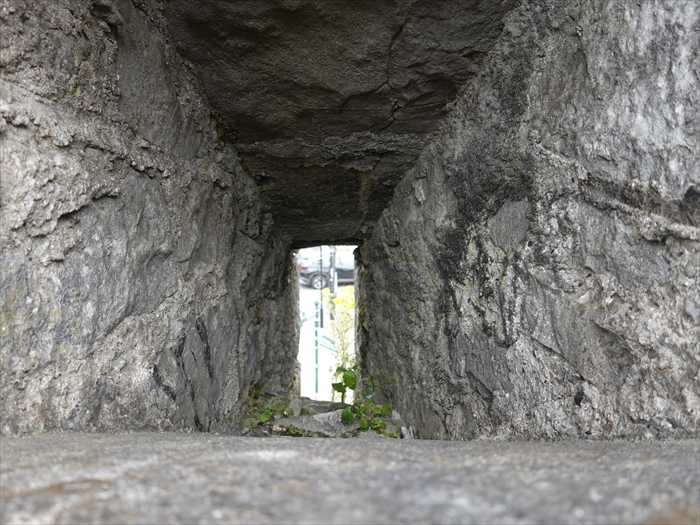
アスローン城(Athlone Castle)の敷地全体を案内する公式見取り図付き解説パネル 。
「 ATHLONE CASTLE
fortification. Soon after 1690, a new barracks was built in the yard and other parts of
the site redeveloped. This area remained in use by the British Army until after 1800.
With the creation of the national monument the courtyard has been excavated and
conserved. The outer moat and entrance rampart have been reconstructed and
interpreted. Numerous buildings have been conserved and repurposed.
The present exhibition includes displays and interpretation of the garrison town and
refurbished buildings.」
【 アスローン城(Athlone Castle)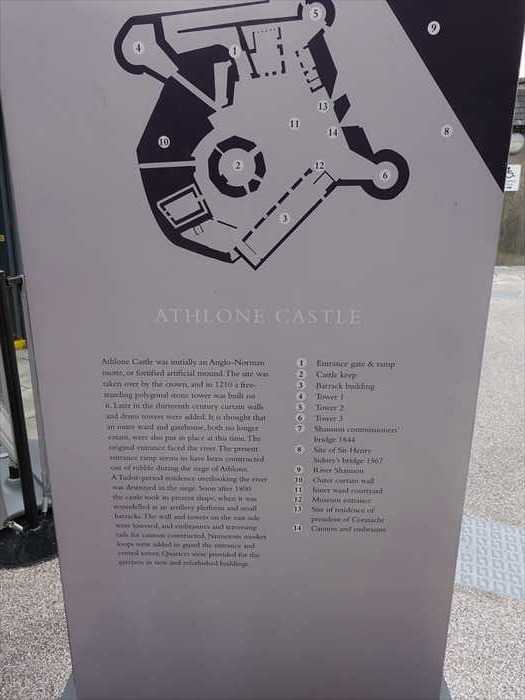
「プレジデントの館(President's House)」跡地 案内。
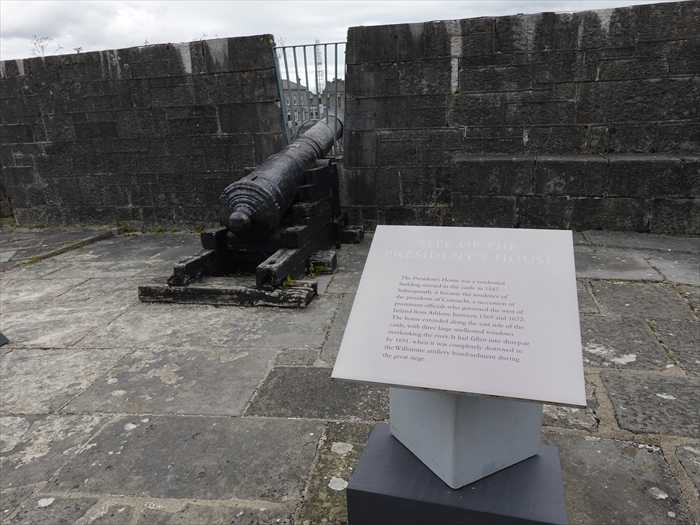
「 SITE OF THE PRESIDENT’S HOUSE
destroyed in the Williamite artillery bombardment during the great siege.」
【 プレジデントの館(President’s House)跡地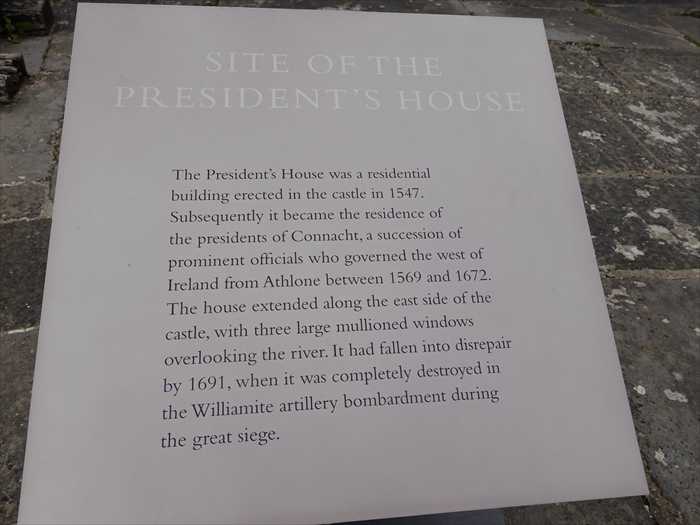
再び、別の 大砲(カノン砲) に近づいて。
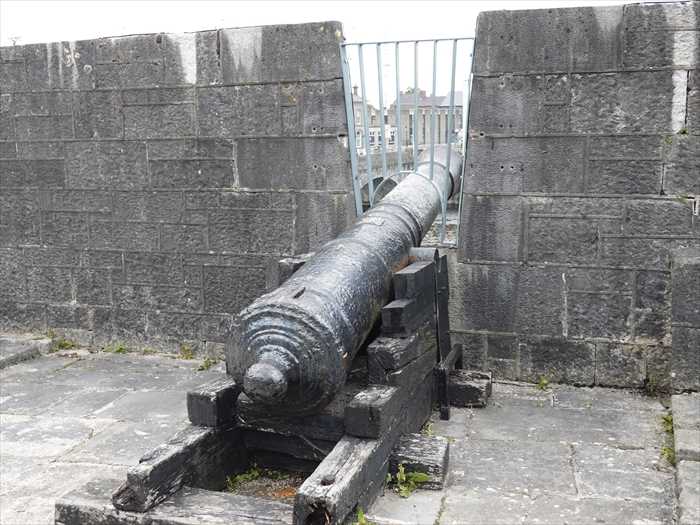
アスローン城(Athlone Castle)から シャノン川(River Shannon)を北方向に望んだ風景 。

城の城壁から シャノン橋 とそに下を ゆったりと流れるシャノン川 、美しく調和した
アスローンの町の見事な景色を楽しむことができるのであった。
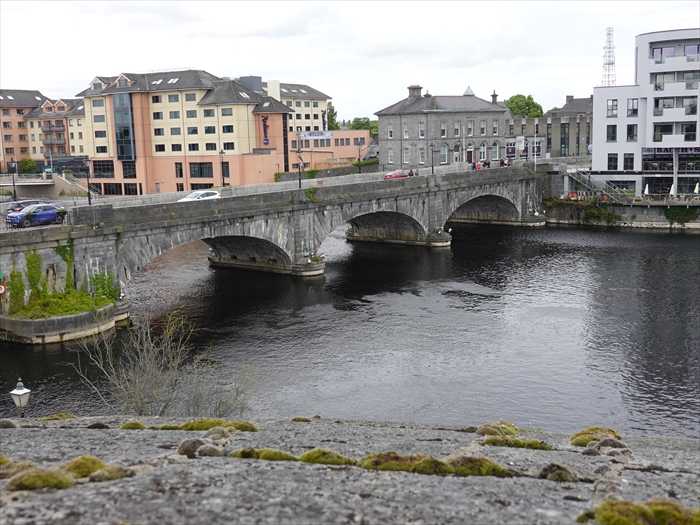
アスローン城(Athlone Castle)の外観を北側(橋側)から 。

・・・ もどる ・・・
・・・ つづく ・・・
巻き込まれた17世紀の代表的な人物を彫刻 で展示している。
攻撃と防御を主導した軍の将軍を含む8人の主要なキャラクターの等身大の彫刻で表現 している
のであった。
COLONEL RICHARD GRACE

近づいて。

「 COLONEL RICHARD GRACE
Colonel Richard Grace (c. 1612–1691) was an Irish Royalist soldier who fought for Charles I, Charles II and James II. He served in the Royalist Army in Exile during the 1650s.
【 リチャード・グレース大佐(約1612年 – 1691年)
リチャード・グレース大佐は、アイルランド出身の王党派(ロイヤリスト)の軍人であり、
1650年代には、亡命中の王党派軍(Royalist Army in Exile)に所属していました。】

「 COLONEL GUSTAVUS HAMILTON 」

「 COLONEL GUSTAVUS HAMILTON
Colonel Gustavus HamiIton (1642-1723 ) ,an lrish protestant丘0n1 County Leitrim,was
a professional soldier. He served on the Continent and afterwards in the lrish army.
a professional soldier. He served on the Continent and afterwards in the lrish army.
ln 1689 he joined the Williamites and took pairt in the early, unsuccessful defence of
Ulster against the Jacobites. Retiring tO England he was given command and of a new
regiment,which he successfully led in the lrish campaign in 1690ー1. He participated in
the major engagements atthe Boyne, Limerick and Aughrim. His most famous exploit
was to lead the grenadiers that spearheaded the brave and successful attack across the
river at Athlone. He subsequently rose to the rank of major general and was made
governor of AthIone. He acquired a large estate in County Meath, became a member 0f
Ulster against the Jacobites. Retiring tO England he was given command and of a new
regiment,which he successfully led in the lrish campaign in 1690ー1. He participated in
the major engagements atthe Boyne, Limerick and Aughrim. His most famous exploit
was to lead the grenadiers that spearheaded the brave and successful attack across the
river at Athlone. He subsequently rose to the rank of major general and was made
governor of AthIone. He acquired a large estate in County Meath, became a member 0f
parliament and eventually peer, with the title Viscount Boyne.
【 グスタヴァス・ハミルトン大佐(1642–1723)
アイルランド・リートリム県出身のプロテスタントで、職業軍人でした。彼は大陸ヨーロッパで
軍務に就いた後、アイルランド軍に所属します。
1689年、彼はウィリアマイト側(ウィリアム3世支持派)に参加し、ジャコバイトに対する
アルスター地方の防衛戦に加わりますが、これは失敗に終わりました。
その後、一時的にイングランドに退却しますが、新たな連隊の指揮官に任命され、1690〜1691年
のアイルランド戦役でその指揮を成功裏に果たしました。
彼は以下の主要戦闘に参加しました:
・ボイン川の戦い(1690)
・リムリック包囲戦
・アウクリムの戦い(1691)
彼の最も有名な功績は、アスローンでのシャノン川渡河作戦において擲弾兵(グレナディア)を
率い、決死の突撃を成功させたことです。
この後、彼は少将(メジャー・ジェネラル)に昇進し、アスローンの総督に任命されました。
アイルランド・リートリム県出身のプロテスタントで、職業軍人でした。彼は大陸ヨーロッパで
軍務に就いた後、アイルランド軍に所属します。
1689年、彼はウィリアマイト側(ウィリアム3世支持派)に参加し、ジャコバイトに対する
アルスター地方の防衛戦に加わりますが、これは失敗に終わりました。
その後、一時的にイングランドに退却しますが、新たな連隊の指揮官に任命され、1690〜1691年
のアイルランド戦役でその指揮を成功裏に果たしました。
彼は以下の主要戦闘に参加しました:
・ボイン川の戦い(1690)
・リムリック包囲戦
・アウクリムの戦い(1691)
彼の最も有名な功績は、アスローンでのシャノン川渡河作戦において擲弾兵(グレナディア)を
率い、決死の突撃を成功させたことです。
この後、彼は少将(メジャー・ジェネラル)に昇進し、アスローンの総督に任命されました。
さらにミース県に広大な土地を所有し、国会議員となり、最終的には「ボイン子爵
(ヴィスカウント・ボイン)」の爵位を授かりました。】
(ヴィスカウント・ボイン)」の爵位を授かりました。】

「 JEAN DE BONNAC MARQUIS D'USSON 」

「 JEAN DE BONNAC MARQUIS D'USSON
Jean Louis d'Usson, Marquis de Bonnac (1672-1738) was French Ambassador to the
Ottoman Empire from 1716 until 1724.[1] One of his main missions was to assure
that the Ottoman Empire remained a threat to the Habsburgs, the main rival of France
in Europe, a regular objective of the Franco-Ottoman alliance. He wrote Mémoire
historique sur l'Ambassade de France à Constantinople.
Ottoman Empire from 1716 until 1724.[1] One of his main missions was to assure
that the Ottoman Empire remained a threat to the Habsburgs, the main rival of France
in Europe, a regular objective of the Franco-Ottoman alliance. He wrote Mémoire
historique sur l'Ambassade de France à Constantinople.
From 1690 to 1694 he was a musketeer. In 1694 he was captain of a dragoons company.
In 1696 he entered the diplomatic service and served as secretary to his uncle fr:François d'Usson de Bonrepaus in Denmark. In 1698 he replaced uncle François d'Usson de
Bonrepaus as Chargé d'affaires in The Hague. In 1700 he was envoy extraordinary to the Principality of Brunswick-Wolfenbüttel, were in 1701 he was replaced by uncle François
d'Usson de Bonrepaus and went to the Court of Stockholm. From 1707 to 1710
he was representative at the court of Stanisław Leszczyński. In May 1711 he replaced
Jean-Denis de Blécourt at El Escorial where he was till 1713 as envoy extraordinary」
In 1696 he entered the diplomatic service and served as secretary to his uncle fr:François d'Usson de Bonrepaus in Denmark. In 1698 he replaced uncle François d'Usson de
Bonrepaus as Chargé d'affaires in The Hague. In 1700 he was envoy extraordinary to the Principality of Brunswick-Wolfenbüttel, were in 1701 he was replaced by uncle François
d'Usson de Bonrepaus and went to the Court of Stockholm. From 1707 to 1710
he was representative at the court of Stanisław Leszczyński. In May 1711 he replaced
Jean-Denis de Blécourt at El Escorial where he was till 1713 as envoy extraordinary」
【ジャン・ルイ・デュッソン、ユッソン侯爵(Marquis de Bonnac)は、1716年から1724年まで
フランスのオスマン帝国駐在大使を務めました。
彼の主な使命の一つは、オスマン帝国がフランスの欧州における宿敵ハプスブルク家に対して
脅威であり続けるよう努めることでした。これはフランス=オスマン同盟の基本的な戦略目標の
一つでした。
脅威であり続けるよう努めることでした。これはフランス=オスマン同盟の基本的な戦略目標の
一つでした。
彼はその経験をまとめて、『コンスタンティノープルにおけるフランス大使館の歴史的回顧録
(Mémoire historique sur l'Ambassade de France à Constantinople)』を著しました。】
(Mémoire historique sur l'Ambassade de France à Constantinople)』を著しました。】

「ジェントルマンの眠る像(Resting Gentleman)」。
・青とオレンジの鮮やかな服装:17世紀のヨーロッパ貴族の軍装風で、カロリング様式の影響を
感じさせます。
感じさせます。
・カツラと羽付き帽子:当時の上流階級の象徴。
・手を胸に置き、横たわる姿勢:死者の像や戦没者の追悼像に共通するポーズ。
・背後の映像:遺体または埋葬された兵士の映像が表示され、歴史的戦争のリアリティと
記憶の継承を意図している。
記憶の継承を意図している。

?????
当時の軍事命令書、戦争記録、または犠牲者名簿のモニュメント的なレプリカ?

AFTERMATH OF THE SIEGE AND REBUILDING」
【 包囲戦の余波と再建 】

「 AFTERMATH OF THE SIEGE AND REBUILDING
After the siege Athlone became a Williamite fortress.
Before marching west, Ginkel had the dead of both sides buried and ordered the streets
of the west town to be cleared of rubble.
of the west town to be cleared of rubble.
So many houses had been demolished in the bombardment that the Williamite garrison
had to be accommodated in tents, although wooden huts were built for the winter.
had to be accommodated in tents, although wooden huts were built for the winter.
Permanent barracks were built in the late 1690s. Most of the inhabitants gradually returned, although there was starvation in Athlone in the winter of 1691–2.
Repair work was undertaken, apparently at the expense of the principal property owners,
who complained strongly of the losses they had incurred in the war.
who complained strongly of the losses they had incurred in the war.
There was a serious setback in 1697, when lightning caused an explosion in the castle
magazine that again destroyed most of the west town.
magazine that again destroyed most of the west town.
However, the recovery was substantially completed by 1709, when a visitor described
Athlone as ‘a handsome large town’.」
【 包囲戦の余波と再建
Athlone as ‘a handsome large town’.」
【 包囲戦の余波と再建
包囲戦の後、アスローンはウィリアマイト軍の要塞となりました。
西へ進軍する前に、ギンケル将軍は両軍の死者を埋葬させ、西側の町の瓦礫を除去させました。
砲撃であまりにも多くの家屋が破壊されたため、ウィリアマイト軍の駐屯兵たちは一時的に
テントに収容され、冬には木造の仮設小屋が建てられました。
テントに収容され、冬には木造の仮設小屋が建てられました。
恒久的な兵舎は1690年代後半に建設されました。住民たちも徐々に戻ってきましたが、1691年
から92年の冬にはアスローンで飢餓が発生しました。
から92年の冬にはアスローンで飢餓が発生しました。
修復作業は主に主要な不動産所有者の費用で行われたとされており、彼らは戦争による損害に
ついて強く不満を訴えました。
ついて強く不満を訴えました。
さらに1697年には落雷によって城の弾薬庫が爆発し、西側の町の大部分が再び破壊されるという
深刻な後退がありました。
深刻な後退がありました。
しかし、復興は1709年までにほぼ完了し、この年にアスローンを訪れたある旅行者は
「立派で大きな町」と表現しています。】
「立派で大きな町」と表現しています。】

「 FORBAIRT AN CHAISLEÁIN I RÉ NAIPÓLÓN
DEVELOPMENT OF THE CASTLE IN THE NAPOLEONIC ERA 」

「 FORBAIRT AN CHAISLEÁIN I RÉ NAIPÓLÓN
DEVELOPMENT OF THE CASTLE IN THE NAPOLEONIC ERA
Athlone Castle largely escaped the 1691 siege undamaged, but by the early 18th century
was in poor repair. In 1703 a Royal Warrant proposed the rebuilding of the castle and
town fortifications. A drawing by Thomas Burgh dated 1707 shows a bastioned
fort on the site.
was in poor repair. In 1703 a Royal Warrant proposed the rebuilding of the castle and
town fortifications. A drawing by Thomas Burgh dated 1707 shows a bastioned
fort on the site.
During the Napoleonic wars (1793–1815) Ireland was viewed as vulnerable to French
invasion. In response, the British government carried out a series of defensive measures, including the upgrading of strategic forts.
invasion. In response, the British government carried out a series of defensive measures, including the upgrading of strategic forts.
In 1797, the Duke of Richmond recommended the rebuilding of Athlone Castle as a depot
and barracks for 1,000 men. By 1807 the fort was armed with 28 cannon and had a
garrison of several hundred men. The barracks were modernised in 1815 and again
in 1826–28.
and barracks for 1,000 men. By 1807 the fort was armed with 28 cannon and had a
garrison of several hundred men. The barracks were modernised in 1815 and again
in 1826–28.
Although later demolished, the barracks formed the structural core of Athlone Castle
as we see it today. Its walls were reinforced, a drawbridge was added, and a bombproof magazine constructed. The castle became a key regional military headquarters and administrative centre for the British army in Ireland.」
【 ナポレオン時代におけるアスローン城の再開発
as we see it today. Its walls were reinforced, a drawbridge was added, and a bombproof magazine constructed. The castle became a key regional military headquarters and administrative centre for the British army in Ireland.」
【 ナポレオン時代におけるアスローン城の再開発
アスローン城は1691年の包囲戦では大きな損傷を免れましたが、18世紀初頭には荒廃が
進んでいました。1703年、王室令により城と町の防御施設の再建が提案され、1707年には
トーマス・バーグによる縄張り図に基づき、稜堡式の要塞として設計されました。
進んでいました。1703年、王室令により城と町の防御施設の再建が提案され、1707年には
トーマス・バーグによる縄張り図に基づき、稜堡式の要塞として設計されました。
ナポレオン戦争(1793~1815年)の時代、アイルランドはフランスからの侵略の可能性があると
見なされていました。そのため、イギリス政府は防衛強化策の一環として、戦略的要塞の
再整備を進めました。
見なされていました。そのため、イギリス政府は防衛強化策の一環として、戦略的要塞の
再整備を進めました。
1797年にはリッチモンド公が、アスローン城を1000人規模の兵舎および物資集積所として
再建することを推奨しました。1807年までにこの要塞は28門の大砲を備え、数百人の兵士が
駐屯していました。兵舎は1815年と1826~28年にも近代化されました。
再建することを推奨しました。1807年までにこの要塞は28門の大砲を備え、数百人の兵士が
駐屯していました。兵舎は1815年と1826~28年にも近代化されました。
これらの兵舎は後に取り壊されましたが、今日私たちが見るアスローン城の構造の中核を
成しています。壁は強化され、跳ね橋が追加され、防爆仕様の弾薬庫も建設されました。
この城は、アイルランドにおけるイギリス軍の地方司令部および行政の中心地となったのです。】
成しています。壁は強化され、跳ね橋が追加され、防爆仕様の弾薬庫も建設されました。
この城は、アイルランドにおけるイギリス軍の地方司令部および行政の中心地となったのです。】

「 (砲台群)

「 Plan of The Batteries (below)
The project shown here was to protect Athlone’s river crossing. It features two major gun batteries, one beside the road and another across the bridge on the south side, with
supporting gun emplacements to the north and south. Note battery at the north
end of the canal is recent.」
【 砲台配置図(下部)
この図面は、アスローンの河川横断地点を防衛するための計画を示しています。2つの主要な
砲台があり、1つは道路のそば、もう1つは橋の南側に位置しています。これを補完する形で、
北と南にも砲座が設置されています。図中、運河の北端にある砲台は比較的新しいものです。】
右:
「 The Batteries (Above)
An immense series of connected artillery emplacements, known as the Batteries,
was erected on the west side of Athlone in the early 1800s. This picture, taken after
the guns had been removed, gives an impression of the size and extent of the works.
was erected on the west side of Athlone in the early 1800s. This picture, taken after
the guns had been removed, gives an impression of the size and extent of the works.
【 砲台群(上部)
「バッテリーズ(砲台群)」と呼ばれる大規模で連結された砲兵陣地が、1800年代初頭に
アスローンの西側に築かれました。この写真は、大砲が撤去された後に撮影されたもので、
構造物の規模と範囲を示しています。】

「 The Dismal Ruine of Athlone(アスローンの悲惨な廃墟)」と、
「Ranelagh School(ラネラ・スクール) 」に関する解説パネル。
左:
「 The Dismal Ruine of Athlone(Below)
Lightning struck the magazine in Athlone Castle in 1697, causing an explosion and
fire that destroyed 64 houses in the west town, newly rebuilt after the destruction of
the siege. Most of the remaining houses were left uninhabitable, and there were
six fatalities.」
【 アスローンの悲惨な廃墟
1697年、アスローン城の弾薬庫に落雷があり、爆発と火災を引き起こしました。この事故で、
西側の町にあった家屋64軒が焼失しました。これらは、包囲戦後に再建されたばかりの
建物でした。残った家々もほとんどが住めない状態となり、6名の犠牲者が出ました。】
右:
「 Ranelagh School(Above)
Established in 1764 with an endowment from the 1st Earl of Ranelagh, the school was
located in a purpose-built building designed by the distinguished Georgian architect,
George Ensor. Its original function was to provide free education for the children of poor protestants.」
【 ラネラ・スクール
1764年、初代ラネラ伯爵からの寄付によって設立されたこの学校は、著名なジョージアン様式
建築家ジョージ・エンソーによって設計された専用の校舎に設置されました。
元々は、貧しいプロテスタントの子供たちに無償の教育を提供することを目的としていました。】

「 BAILE ÁTHA LUAIN MAR BHAILE GARASTÚIN
ATHLONE AS A GARRISON TOWN 」

「 BAILE ÁTHA LUAIN MAR BHAILE GARASTÚIN
ATHLONE AS A GARRISON TOWN
home of the Irish Defence Forces, who renamed it Custume Barracks in honour of
Sergeant Custume, a hero of the 1691 siege.」
【 アスローンの軍事駐屯地としての役割
The original army barracks, built after 1700, housed up to 1000 men and included
a hospital and chapel.
a hospital and chapel.
The second barracks, Custume Barracks, was completed in the 1830s and became the headquarters of the British army’s 4th Western Division in Ireland.
During the 19th and early 20th centuries, it played a major role in British military
operations in Ireland and was one of the largest military facilities in the country.
operations in Ireland and was one of the largest military facilities in the country.
Athlone also became a key training centre for new recruits, and British regiments
regularly rotated through the garrison. The presence of the army had a significant social
and economic impact on the town, providing employment and stimulating local trade.
After the Anglo-Irish Treaty in 1921, the British withdrew and the barracks became theregularly rotated through the garrison. The presence of the army had a significant social
and economic impact on the town, providing employment and stimulating local trade.
home of the Irish Defence Forces, who renamed it Custume Barracks in honour of
Sergeant Custume, a hero of the 1691 siege.」
【 アスローンの軍事駐屯地としての役割
最初の兵舎は1700年以降に建てられ、最大で1,000人の兵士を収容し、病院や礼拝堂も
備えていました。
備えていました。
1830年代には第二兵舎である「カスチューム兵舎(Custume Barracks)」が完成し、
イギリス陸軍第4西部師団の本部となりました。
イギリス陸軍第4西部師団の本部となりました。
19世紀から20世紀初頭にかけて、アイルランドにおけるイギリス軍の作戦において主要な
拠点として機能し、国内最大級の軍事施設の一つでした。
拠点として機能し、国内最大級の軍事施設の一つでした。
アスローンは新兵訓練の中心地ともなり、多くのイギリス連隊が駐留し交代しました。
軍の存在は町の社会・経済に大きな影響を与え、雇用を生み、地元の商取引を活性化させました。
軍の存在は町の社会・経済に大きな影響を与え、雇用を生み、地元の商取引を活性化させました。
1921年の英愛条約(アングロ・アイリッシュ・トリーティ)後、イギリス軍が撤退し、兵舎は
アイルランド国防軍の基地となり、1691年の包囲戦の英雄であるカスチューム軍曹
(Sergeant Custume)にちなんで「Custume Barracks」と改称されました。】
アイルランド国防軍の基地となり、1691年の包囲戦の英雄であるカスチューム軍曹
(Sergeant Custume)にちなんで「Custume Barracks」と改称されました。】

アイルランドとアスローンの社会・政治・軍事史に関する年表パネル ?
ピンボケであったが
年代や出来事ごとに異なる色(黄色・ピンク・青・緑など)でデザインされており、来場者に
歴史の流れを印象づけやすいように工夫されていた。
年代や出来事ごとに異なる色(黄色・ピンク・青・緑など)でデザインされており、来場者に
歴史の流れを印象づけやすいように工夫されていた。
写真やドキュメントの複製も混在しており、社会運動、戦争、政治運動、教育、宗教などの
複数のテーマを扱っているようであった。
複数のテーマを扱っているようであった。

大型の銀製トロフィー。
アスローン周辺で行われたスポーツ競技(特にボートレースやラグビー、あるいは地元の軍事
関連行事)に関する記念杯であっただろうか?

アスローン城(Athlone Castle)の上階・窓越しから、 シャノン川に架かる
アスローン橋(Athlone Bridge)を見下ろす 。
手前の石壁部分は、城の砲台( battery
)で、 黒い大砲(レプリカもしくは保存された実物)
が
2門並んでいた。
2門並んでいた。
これらの砲は、1691年の「アスローン包囲戦(Siege of Athlone)」や、その後のナポレオン
戦争期(19世紀初頭)に使用された防衛設備を再現または保存しているもの。
戦争期(19世紀初頭)に使用された防衛設備を再現または保存しているもの。
砲口はシャノン川と橋の方向を向いており、かつての戦略的防衛ポイントである
ことを
示しているのであった。
シャノン川と橋を制することで、アイルランド東西を結ぶ交通と軍事の要衝を掌握できた ことが
理解できたのであった。
示しているのであった。
シャノン川と橋を制することで、アイルランド東西を結ぶ交通と軍事の要衝を掌握できた ことが
理解できたのであった。

蒸気ホイッスル(steam whistle) と呼ばれる、かつて工場でシフト交代用に
使用されていた音響信号装置。

「 Gentex factory hooter
General Textiles Limited (Gentex), a cotton manufacturing plant, made an enormous
contribution to the economy and general life of Athlone during the nearly fifty years of its existence. Shift changes were indicated by the factory hooter, which was audible
throughout the town.」
【 ジェンテックス工場のホイッスル(サイレン)
「ジェネラル・テキスタイルズ社(Gentex)」は、綿織物の製造工場であり、その約50年に
わたる操業期間において、アスローンの経済および市民生活に多大な貢献を果たしました。
工場でのシフト交代の合図には、このホイッスル(サイレン)が使われており、その音は町中にわたる操業期間において、アスローンの経済および市民生活に多大な貢献を果たしました。
鳴り響いていたのです。】

アスローン城(Athlone Castle)の上階、 屋上の砲台跡(バッテリー)に通じる
出入り口付近 。

アスローン城(Athlone Castle)の砲台跡に据え付けられている 歴史的な大砲(カノン砲) を
後方から
・黒色の鋳鉄製砲身:17世紀〜19世紀の典型的な設計。 弾丸を発射するための滑腔砲(rifleなし)
。
・ 木製の砲架(carriage)
に載せられており、左右の木枠で支えられている。
・ 発射口は、シャノン川の対岸に向けられ ており、 橋や市街地の方向を警戒・防衛 していた。
・ 発射口は、シャノン川の対岸に向けられ ており、 橋や市街地の方向を警戒・防衛 していた。

再び、 アスローン城(Athlone Castle)の主塔(ドンジョン/keep) を正面から。
・ 多角形の構造:砲撃や攻撃に強い形状
。
・中世〜17世紀様式の石造建築: 厚い石壁と小さな開口部(銃眼)
が。
・上部に設けられたマーダーホール(murder holes)風の開口: 敵に対して上から攻撃できる構造
。
・正面入口には、現代的なガラス製のスロープと手すりが追加され、 バリアフリー対応
が。
中央:迫撃砲(モルタル)タイプの大砲:通常のカノン砲よりも 角度が高く、弾を上空に
放物線状に 発射するため、城壁越えの攻撃などに用いられていたのであろう。
中央:迫撃砲(モルタル)タイプの大砲:通常のカノン砲よりも 角度が高く、弾を上空に
放物線状に 発射するため、城壁越えの攻撃などに用いられていたのであろう。

アスローン城(Athlone Castle)の 屋上バッテリー(砲台)エリアから、聖ペテロ・聖パウロ教会(Church of Saints Peter and Paul)を背景に 。

訪問者向けの体験型展示(インタラクティブエリア)の一環として、 大型チェスセット が
設置されていた。

歴史的な戦略や対決を象徴的に表現する 意図が込められているのか?
( 城=戦略=チェス という文脈??)。

中世および近世の城や要塞において設けられた 防御射撃用の狭い開口部
。
外からは非常に狭く見えるが、内側は広く作られており、兵士が弓矢、銃、あるいは火器で
攻撃するための視界・射界を確保できるよう工夫 されているのであった。
攻撃するための視界・射界を確保できるよう工夫 されているのであった。

アスローン城(Athlone Castle)の敷地全体を案内する公式見取り図付き解説パネル 。
「 ATHLONE CASTLE
Athlone Castle was initially an Anglo-Norman motte or fortified mound. The site was
taken over by the crown in 1210; stone walls and large-scale battlements were built
soon after. The original structure was replaced in both height and outer wall shape
and extended into this irregular enclosure with fine radial pattern. The present curtain
walls were faced in the 19th century over rubble coursing.
At the outbreak of the war for Athlone, there was a royal garrison inside the stonetaken over by the crown in 1210; stone walls and large-scale battlements were built
soon after. The original structure was replaced in both height and outer wall shape
and extended into this irregular enclosure with fine radial pattern. The present curtain
walls were faced in the 19th century over rubble coursing.
fortification. Soon after 1690, a new barracks was built in the yard and other parts of
the site redeveloped. This area remained in use by the British Army until after 1800.
With the creation of the national monument the courtyard has been excavated and
conserved. The outer moat and entrance rampart have been reconstructed and
interpreted. Numerous buildings have been conserved and repurposed.
The present exhibition includes displays and interpretation of the garrison town and
refurbished buildings.」
【 アスローン城(Athlone Castle)
アスローン城は、もともとアングロ・ノルマンによって築かれたモット(motte:築山)型の
要塞でした。1210年にイングランド王室の管理下となり、間もなく石造の城壁と大規模な
防御設備が建設されました。
要塞でした。1210年にイングランド王室の管理下となり、間もなく石造の城壁と大規模な
防御設備が建設されました。
元の構造はその後、高さや外壁の形状が変更され、現在見られる不規則な囲い型の構造に
拡張されました。外壁は19世紀に瓦礫石の上に仕上げ材が施され、今日に至っています。
拡張されました。外壁は19世紀に瓦礫石の上に仕上げ材が施され、今日に至っています。
1690年のアスローン包囲戦勃発時には、石造の要塞内部に王党派の駐屯兵がいました。
戦後まもなく、中庭には兵舎が新設され、敷地全体が再整備されました。このエリアは
1800年以降もイギリス軍によって使用されました。
戦後まもなく、中庭には兵舎が新設され、敷地全体が再整備されました。このエリアは
1800年以降もイギリス軍によって使用されました。
現在、国定記念物(national monument)として中庭は発掘・保存され、外堀や出入口の土塁も
復元されました。敷地内の多くの建物は保存・再活用され、アスローン城と駐屯地の歴史に
関する展示が設けられています。】
1.Entrance gate & ramp(入口・傾斜路)
復元されました。敷地内の多くの建物は保存・再活用され、アスローン城と駐屯地の歴史に
関する展示が設けられています。】
1.Entrance gate & ramp(入口・傾斜路)
2.Castle Keep(主塔)
3.Rebuilding(再建部分)
4.Tower 1(塔1)
5.Tower 2(塔2)
6.Tower 3(塔3)
7.Sharrow Commissioners’(シャロウ委員)
8.Siege of St. Henry(聖ヘンリー包囲)
9.Siege of Bridge 1691(橋の包囲戦 1691年)
10.Master Gunner's Yard(火砲指揮官の中庭)
11.Inner redoubt courtyard(内側の防御中庭)
12.Site of entrance of outer redoubt(外郭入口跡)
13.Muster and courtyard(召集地と中庭)
14.Cannon and embrasure(大砲と銃眼)

「プレジデントの館(President's House)」跡地 案内。

「 SITE OF THE PRESIDENT’S HOUSE
The President’s House was a residential building erected in the castle in 1547.
Subsequently it became the residence of the presidents of Connacht, a succession of
prominent officials who governed the west of Ireland from Athlone between
1569 and 1672.
The house extended along the east side of the castle, with three large mullioned windows overlooking the river. It had fallen into disrepair by 1691, when it was completelySubsequently it became the residence of the presidents of Connacht, a succession of
prominent officials who governed the west of Ireland from Athlone between
1569 and 1672.
destroyed in the Williamite artillery bombardment during the great siege.」
【 プレジデントの館(President’s House)跡地
プレジデントの館は、1547年に城内に建てられた住宅建築です。その後、この建物はコノート地方(Connacht)のプレジデント(総督)の官邸として使用されました。
プレジデントとは、1569年から1672年の間にアスローンを拠点にアイルランド西部を統治した
高官たちのことです。
プレジデントとは、1569年から1672年の間にアスローンを拠点にアイルランド西部を統治した
高官たちのことです。
この館は城の東側に沿って建てられ、シャノン川を望む3つの大きな格子窓(マリオンウィンドウ)
がありました。1691年までにすでに老朽化していましたが、アスローン包囲戦中の
ウィリアマイト軍による大砲砲撃で完全に破壊されました。】
がありました。1691年までにすでに老朽化していましたが、アスローン包囲戦中の
ウィリアマイト軍による大砲砲撃で完全に破壊されました。】

再び、別の 大砲(カノン砲) に近づいて。

アスローン城(Athlone Castle)から シャノン川(River Shannon)を北方向に望んだ風景 。
川にはプレジャーボートが係留されており、アスローンが水運や観光クルーズの拠点でも
あることが理解できた。
あることが理解できた。
アスローンは、シャノン川を利用した遊覧船(Viking Toursなど)の出発地
にもなっていた。

城の城壁から シャノン橋 とそに下を ゆったりと流れるシャノン川 、美しく調和した
アスローンの町の見事な景色を楽しむことができるのであった。
現在の石橋は1844年に完成
したもので、それ以前にも同地点に複数の橋が建てられていた。
かつてこの橋は、アイルランドの東西を結ぶ最重要ルートの一つであり、軍事・商業上の
戦略的要地であった。
戦略的要地であった。
城の砲台からも橋を狙える位置!!
中央の灰色の石造建物は、歴史的な官庁建築であり、現在も地元行政の一部が使用している と。
中央の灰色の石造建物は、歴史的な官庁建築であり、現在も地元行政の一部が使用している と。

アスローン城(Athlone Castle)の外観を北側(橋側)から 。
・中央の円形の建物は、アスローン城の心臓部にあたる円形ドンジョン(keep)。
これはノルマン様式の要塞によく見られる設計で、元は12世紀に築かれたものを基にしている。
これはノルマン様式の要塞によく見られる設計で、元は12世紀に築かれたものを基にしている。
・城の正面にある半円形の砲塔状構造物は、近代化された防御設備で、18〜19世紀にかけて
追加された部分。石の積み方と砲座の形から、火砲に対応した構造であることが分かります。
追加された部分。石の積み方と砲座の形から、火砲に対応した構造であることが分かります。
・左奥にはアイルランド国旗(緑白橙)、右の塔には別の旗(恐らく博物館の紋章)が
掲げられていた。
掲げられていた。
・城の壁に沿って続く石造の斜路(ランプ)は、大砲や物資を運搬するための通路として
設けられたものであろうか。
設けられたものであろうか。

・・・ もどる ・・・
・・・ つづく ・・・
お気に入りの記事を「いいね!」で応援しよう
【毎日開催】
15記事にいいね!で1ポイント
10秒滞在
いいね!
--
/
--
© Rakuten Group, Inc.










